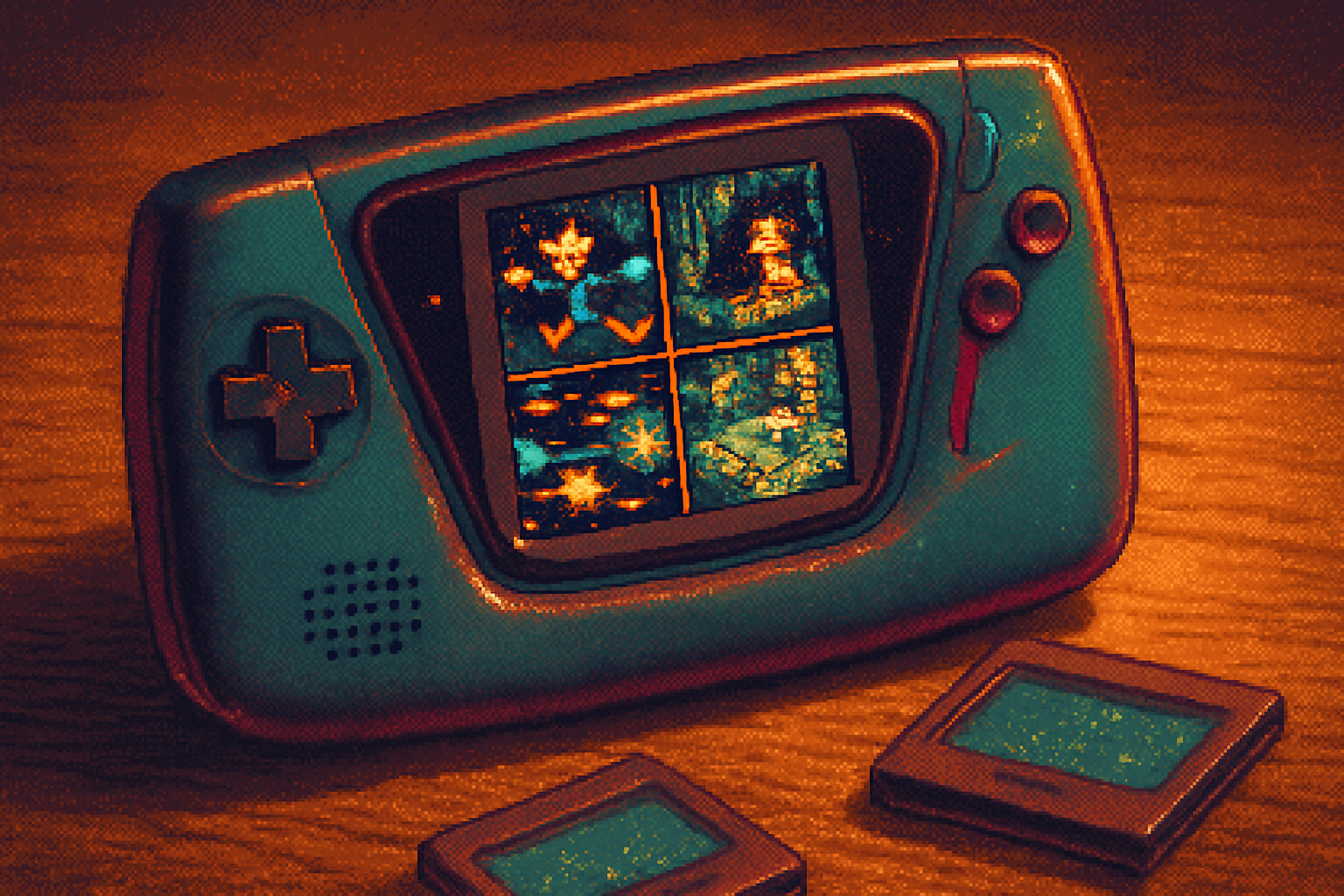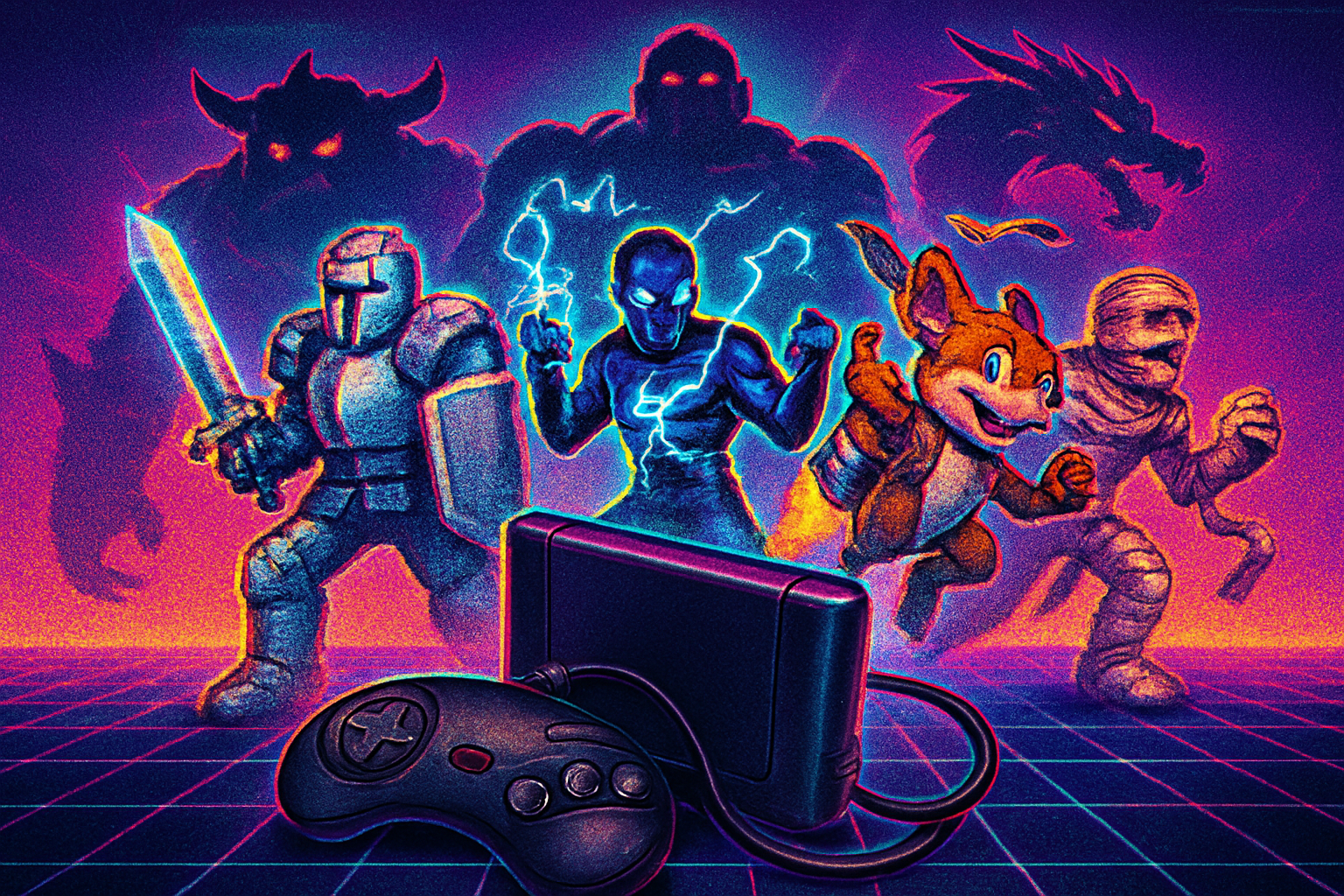· retrogaming · 6 min read
Reviving the Game Gear: A Look at Obscure Classics Worth Rediscovering
Dust off the Game Gear. Beyond Sonic and columns lies a clutch of odd, brilliant, and technically daring cartridges that show the handheld’s personality - games that deserve a second look from modern players and preservationists.

I found mine in a box behind a VHS of Ocean’s Eleven - a dusty, inch-thick Game Gear with a cartridge still half stuck in the slot. I pressed power, squinted at the tiny backlit screen, and watched a goofy, pixel-perfect tail wag across a world that should not have fit inside a handheld made in 1991. The moment was small. It was also impossible to forget.
The Sega Game Gear is usually remembered as a rich cousin of the Master System, the handheld that tried harder: color screen, backlight, a battery appetite worthy of a small furnace. Most people remember Sonic, Columns, and a parade of Genesis ports. But tucked between the familiar names are titles that feel personal, experimental, or just plain strange - games that never got the marketing muscle they deserved.
This article is for the players who like their nostalgia with a dose of discovery. Below are seven Game Gear games - obscure, uneven, lovable - that I think are worth rescuing from attic limbo.
Why revisit Game Gear now?
- The handheld is a compact time capsule - short sessions, sharp design constraints, and a surprisingly varied library.
- Modern tastes reward oddball mechanics and bite-sized systems; these games often deliver that in spades.
- Preservation is urgent. Many cartridges are region-locked or Japan-only, and physical media ages. If you care about gaming history, this is low-hanging fruit.
For a primer on the hardware and its history see the Game Gear page on Wikipedia: https://en.wikipedia.org/wiki/Game_Gear
How to approach these games today
- Official re-releases exist but are spotty. Some titles have shown up on compilations or mini-console lineups; many haven’t.
- Emulation is the most convenient route, but be mindful of legality and support for preservation initiatives. If you own the original cartridge, playing a ROM for convenience is widely accepted among collectors.
- If you want the tactile joy, flashcarts and repro services (EverDrive-style carts) exist for Game Gear, and original cartridges still change hands frequently.
Now for the games.
Tails Adventure - A tiny, oddball Metroidvania
Tails Adventure looks like a kids’ platformer - and, in ways, it is. But beneath the cheerful façade is a deliberate, exploration-first design: item-based progression, backtracking, and tiny towns where you trade parts and overhear NPC gossip. The pacing is serpentine; combat is forgiving; the reward is atmosphere.
Why it matters
- It’s an early example of a handheld Metroidvania vibe, executed with charm rather than pretension.
- The game demonstrates what the Game Gear could do when teams treated the platform as something other than a Genesis shrink-small worlds with personality.
Where to start
- Expect deliberate exploration, not Sonic-speed thrills. Play with patience and a map. The game rewards curiosity.
Pulseman - Slick animation and a bouncy experimental platformer
- Wikipedia: https://en.wikipedia.org/wiki/Pulseman
Created by Game Freak before they were synonymous with pocket monsters, Pulseman is a visually spry platformer. It’s a fluorescent showpiece: flashy sprites, elastic movement, and level design that encourages chaining momentum.
Why it matters
- It looks and moves unlike many contemporaries. There’s a certain Game Boy-era inventiveness here - a studio trying to teach itself new tricks.
- Historically interesting because of the studio behind it and its restrained, creative ambition.
Where to start
- The game’s difficulty ramps; use the momentum mechanics to stitch together runs. And if you love odd audiovisual flourishes, this one’s for you.
GG Aleste - A blistering shoot-’em-up in miniature
- Wikipedia: https://en.wikipedia.org/wiki/GG_Aleste
Shooter fans will find GG Aleste to be a concentrated masterclass in how to make a shmup feel explosive on limited hardware. Tight hitboxes, memorable weapon power-ups, and stages that stack challenge without cruelty.
Why it matters
- It’s proof the Game Gear could host skilled, arcade-quality action without feeling compromised.
- The pacing is relentless - short stages that still demand precision and pattern memorization.
Where to start
- Treat it like an arcade game - learn the power-up routes, hug your hitbox, and don’t get cocky.
Master of Darkness - Gothic tone, 8-bit bravado
Master of Darkness is a weirdly ambitious horror-themed platformer that borrows from Castlevania’s wardrobe and gives it a gritty, street-level twist. It’s less refined than Konami’s classics, but that roughness adds personality.
Why it matters
- The atmosphere is rare on handhelds of the era - foggy moors, urban decay, and lamps that matter.
- It’s a showcase for developers willing to ape big-genre ideas on a tiny canvas and still produce something memorable.
Where to start
- Expect trial-and-error boss fights and platforming that rewards patience. Let the mood sink in; it’s half the attraction.
Ristar (Game Gear) - A surprisingly good shrink of a console classic
- Wikipedia: https://en.wikipedia.org/wiki/Ristar
Ristar’s Game Gear version is not merely a lossy port; it’s an exercise in adaptation. The levels have been redesigned to suit the handheld, and the stretchy-armed platforming retains its personality.
Why it matters
- It’s a rare example of a portable version that stands on its own merits instead of just being a smaller Sonic.
- Play it if you want a platformer that respects the constraints of the medium while staying ambitious.
Where to start
- Don’t play it expecting Genesis-level graphics; play it for level design and the elastic combat.
Sonic Labyrinth - Strange experiments from a predictable franchise
Sonic Labyrinth is the franchise’s awkward adolescent experiment: an isometric, puzzle-platformer hybrid where Sonic trades run-and-jump for top-down momentum and rubik’s-cube dungeons. Many players found it frustrating; a few find it fascinating.
Why it matters
- It proves even the most mainstream franchises can take strange detours. The result is uneven, but fascinatingly singular.
- For collectors and curious players, it’s a case study in what happens when design orthodoxy gets bent.
Where to start
- Go in knowing it’s not a typical Sonic game. Patience and puzzle-logic will take you further than reflexes.
Shining Force Gaiden (Game Gear) - Tactical RPGs in bite-sized form
The Shining Force Gaiden titles transplant the tactical-rpg bones of their console cousins into short, portable campaigns. Battles are compact; characters are memorable; the strategic loop translates well to short play sessions.
Why it matters
- A brilliant demonstration of how deep systems can be scaled down without losing soul.
- These games are a great entry point for players curious about tactical RPGs but wary of 40-hour investments.
Where to start
- Keep save points in mind. These are games designed around portable play, so they’re merciful in short sittings.
Practical tips for digging deeper
- If you want authenticity - hunt physical cartridges and a worked Game Gear. Clean contacts gently with isopropyl alcohol.
- If you want convenience - look for modern compilations or EverDrive-style flashcarts that let you load multiple ROMs to real hardware.
- For preservation - support projects and creators working on official re-releases. The easiest way to keep these games alive is to make them accessible legally.
Final verdict: Why care?
The Game Gear’s library is uneven. Some cartridges are corporate echoes - rushed ports, needless license plates of movie tie-ins. But the obscurer titles carry a quality that’s hard to quantify: a willingness to experiment, to condense bold ideas into palm-sized ludic diaries. They’re games made under constraints, and constraints can be creative fertilizer.
So if you stumble across a dusty Game Gear, plug it in. If you’re browsing ROM lists, give one of the games above a try. You might not find a perfect title. But you will find attitude, invention, and - occasionally - genius squeezed into a cartridge that the market forgot.
References
- Game Gear - https://en.wikipedia.org/wiki/Game_Gear
- Tails Adventure - https://en.wikipedia.org/wiki/Tails_Adventure
- Pulseman - https://en.wikipedia.org/wiki/Pulseman
- GG Aleste - https://en.wikipedia.org/wiki/GG_Aleste
- Master of Darkness - https://en.wikipedia.org/wiki/Master_of_Darkness
- Ristar - https://en.wikipedia.org/wiki/Ristar
- Sonic Labyrinth - https://en.wikipedia.org/wiki/Sonic_Labyrinth
- Shining Force Gaiden - https://en.wikipedia.org/wiki/Shining_Force_Gaiden



